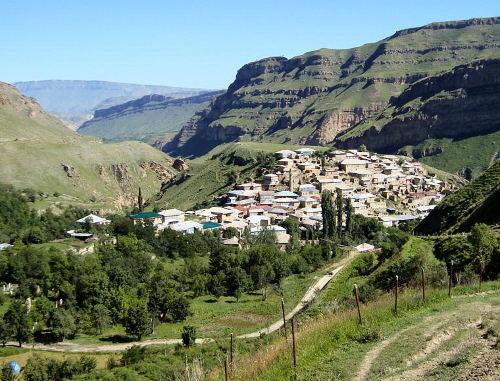
Ethnic Laks in Dagestan Organize to Defend Their Rights
Publication: Eurasia Daily Monitor Volume: 9 Issue: 183
By:

The Lak National Council was established at a conference in Makhachkala on September 28 that was attended by 427 delegates from Dagestan’s Lak, Novolak and Kuli districts and towns with a significant population of ethnic Laks. The former head of the Dagestani branch of the Russian Pension Fund, Amuchi Amutinov, was elected head of the Lak National Council. The Laks’ attempt at self-organization was triggered by the republic’s mounting security concerns. According to one of the organizers of the conference, Ilyas Kayaev, many participants said “there is a civil war going on in Dagestan” and the trend was pointing toward “a full-scale civil confrontation” in the republic. The primary concern at the conference was land ownership—the issue of disputed land (https://www.kavkaz-uzel.ru/articles/213345/).
In 1943, part of Dagestan’s Khasavyurt district bordering Chechnya was transformed into a separate district called the Aukhov district. The newly created district was populated predominantly by ethnic Chechens, also known as Chechens-Akkins. A few months later, in 1944, all ethnic Chechens and ethnic Ingush living in the North Caucasus were deported en masse to Kazakhstan and parts of Central Asia as punishment for their alleged collaboration with the Germans. The decision to create a separate Chechen district within Dagestan may have been part of preexisting plans in the Kremlin to pave the way for the Chechens’ isolation and deportation.
The Aukhov district was renamed Novolak (New Lak) district as ethnic Laks were resettled there from the mountainous areas of Dagestan. In the 1980s, as the political climate in the USSR relaxed, the Chechens of Dagestan started to raise the issue of returning to their lands and restoring the Aukhov district. In 1991, a conference of Dagestani people’s deputies passed a resolution to resettle ethnic Laks in specially designated areas of Dagestan and restoring the Aukhov district for its Chechen residents. This decision, however, never was implemented due to a number of factors. The new land for resettling the Laks was not properly prepared and was generally of low quality, and ethnic Kumyks opposed the Laks’ return. Most importantly, there were two Russian-Chechen wars and Moscow was certainly reluctant to help the Chechens against the Dagestanis.
Currently, nearly 50 percent of the Novolak (aka Aukhov) district’s population is made up of ethnic Laks, while ethnic Chechens make up almost 30 percent and ethnic Avars make up the rest of the district’s population. According to the 2010 census, there were 94,000 ethnic Chechens and 161,000 Laks living in Dagestan (Russian State Statistical Service, www.gks.ru). The Lak people’s gathering is an indicator of the increased fracturing of the Dagestani government. This largest and most ethnically diverse republic in the North Caucasus experienced substantial ethnic mobilization in the 1990s. Apparently, ethnic identity is reacquiring its saliency as the situation in Dagestan shows no signs of improvement, while the authorities in the republic and across Russia appear unable to mediate ethnic tensions as impartial arbiters.
The Lezgin ethnic autonomy’s representative, Ruslan Gereyev, who attended the Laks’ gathering, told Kavkazsky Uzel (Caucasian Knot) that the Laks’ problems were very common throughout Dagestan. “People want and are forced to determine their own future, because they do not trust the state authorities,” Gereyev said. “From the [ordinary people’s] standpoint, the situation with [land] issues is not only not getting resolved, but is getting worse with each passing day” (https://www.kavkaz-uzel.ru/articles/213345/). Interethnic relations in Russia have been deteriorating for some time now, so the situation in the country must have had some influence on Dagestan as well, which made people organize along ethnic lines.
On October 6, police in the Moscow region issued a special warning to Dagestani soccer fans ahead of a match taking place the following day in the city of Khimki just outside Moscow between Moscow’s Dinamo soccer team and Dagestan’s Anzhi soccer team. “Given the fact that an unfavorable situation has been created around the fans of the soccer club Anzhi, the likelihood of unlawful actions against them in the Moscow region is high,” the police warned. Back on September 30, members of a Dagestani wedding procession in Moscow fired guns in the air, provoking a large-scale hostile response from the Russian public, which put the authorities under pressure to respond to the public outcry (https://www.gazeta.ru/sport/news/2012/10/07/n_2560297.shtml).
On October 2, Prime Minister Dmitry Medvedev paid a surprise visit to Dagestan. In Makhachkala, Medvedev stated that he had signed a decree that would allot an additional $700 million for infrastructural and other long-term projects in the North Caucasus in 2012–2013. He further urged the chiefs of the Russian federal agencies and ministers to visit the North Caucasus region regularly (https://kommersant.ru/doc/2036107?isSearch=True).
This is yet another indication of Moscow’s wish to increase administrative control over the North Caucasus. Increasing administrative control over local bureaucracies would not have been an inherently negative development if this process had been accompanied by democratic reforms. However, under the current circumstances, when there is only an increase in control and a concentration of military and security forces in the region with no expansion in freedoms, Moscow’s initiatives in the North Caucasus are likely to be seen as hostile political pressure that will result in greater volatility of the region, rather than its pacification.




